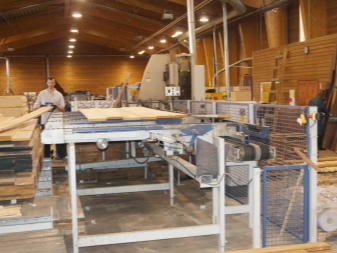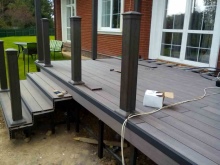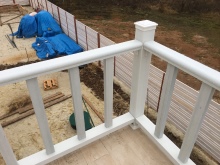All about WPC fences

Increasingly, in country houses, cottages and public spaces, decorative fences made of WPC are found, which are gradually replacing standard metal and wooden structures. It is worth considering in more detail what such fences are and how to install them.



Peculiarities
WPC fencing is a modern terrace construction with a wood component.
Before making a product, wood is ground into flour. Its maximum amount in the total mass of the feedstock is 50-80%.
At the same time, for the production of WPC, they use:
- trimming lumber;
- the remains of logs;
- twigs and branches.
The rest of the wood-polymer raw materials are thermoplastic polymers modified with synthetic additives and dyes. The proportions of the composite are determined by the preferences of the manufacturers, which, as a result, affects the final cost of the product and the parameters.

Advantages of WPC fences:
- long service life;
- natural appearance;
- no additional costs during operation;
- high strength and resistance to external influences and temperature extremes.
Another plus of the material is that it is easy to saw, cut and deform if necessary. Unlike wood structures, WPC does not require special care in the form of impregnation of the coating with antiseptics or staining.
When choosing a decorative fence, it is recommended to pay attention to the fact that a product in which there are a lot of polymers looks more like plastic. In addition, the polymer can affect the final characteristics of the material. For the manufacture of budget products, manufacturers use polyethylene, which is noticeably inferior in quality to more expensive WPC modifications.
As for the disadvantages of decorative fencing, scratches are mainly noted in the case of deep mechanical impacts on the surface of the coating. At the same time, the defect can be eliminated with the help of a special corrector pencil, which is suitable for wood restoration.


Species overview
Today, manufacturers produce different types of decorative fences. Products may differ in material composition, design and other characteristics.
The owner of a country house can equip himself with a decking veranda or install a balcony railings.
There are many types of decorative fencing. It is worth considering in more detail the most common, among which there are fences both for the balcony or porch, and for the territory of the suburban area as a whole.



Ready sections
The classification of WPC by frame type implies the presence of products in the form of finished sections. The advantage of these designs is easy installation. All that needs to be done is to install the finished wall panels in the ground.



Lattice fences
The second type of WPC is of the type of frame, which implies the installation of individual boards on transverse joists with supports. It takes more time to install, but it has an attractive look.
In turn, fences also have their own classification.
- Classic fences. They are standard vertical boards installed in a row. Moreover, in the case of small fences, a foundation device is not even required, it is enough to drive the boards into the ground to an equal height. The difference between a classic fence is the installation of material with a certain step.
The properties of such structures include ease of installation, a small budget and a variety of options.


- Picket fences. A popular type of fence. The piles are used as the base, on which horizontal beams are subsequently installed, which are necessary for fixing composite boards. Installation of such a fence will give the feeling of being in Western countries, the picket fence is neat and open.



- Country. A subtype of picket fence, the difference of which is the presence of additional diagonal struts. The profile is used mainly to separate the zones of the cottage. The disadvantage of the view is the high price.


- Monolith. Differs in tight fastening of the fence to the foundation. Such fences have no gaps, which results in a solid hedge. It is mainly used for fencing a suburban area.


Finally, decorative WPCs, which use a special patterned structure, are a separate category. For such fences, carved fences, weaves and figured structures are characteristic.

Tools and materials selection
Before proceeding with the independent installation of the structure, it is recommended to prepare the necessary tools and materials. Externally, a decorative fence is a special material, and therefore requires the use of unusual details.

The main components of the WPC.
- Fencing post. Has a square shape, hollow inside. Also, the post is equipped with stiffening ribs to increase the strength of the structure.
- Pole bracket. Used as a base. The brackets are made of high-strength steel, which ensures the reliability of the fence.
- Pole skirt. It is a special cover that allows you to hide the connection between the pillar and the terrace covering. Usually comes complete with the enclosing structure, since the elements should not differ in size or color.
- Lid. Decor, which is produced in the form of a standard plug. The cover is inserted into the post at the top to prevent debris from entering the end.
- Handrail. Available in different shapes. In some cases, this element acts as a sub-baluster bar.
- Plastic fasteners for balusters. Allows you to fasten balusters to horizontal strips and ensure the strength of the connection. They are selected depending on the shape of the profile.
- Inclined fasteners. They are necessary when it comes to mounting balusters at an angle.
- Fasteners for handrails. They are produced in two types - straight and hinged. Fastening is carried out by connecting horizontal strips and supporting pillars.



Additionally, it is worth purchasing fasteners to connect the structure to the base of the terrace.
Fasteners can be different, they must be selected depending on the base material.
The peculiarity of the WPC is modularity. This allows for a minimal set of tools. To install the fence you will need:
- puncher;
- screwdriver;
- saw;
- building level.

It is not recommended to mount the WPC alone, it is better to invite assistants. You may also need a tape measure, pencil, hammer, etc. as tools.


Mounting
When the necessary materials and tools are ready, you can start installing the fence with your own hands. There are several ways to install the WPC, depending on the type of construction. It is worth considering in more detail the installation of a classic model of a decorative fence. In this case, you will need to complete a number of steps.
- Install the brackets on which the post will subsequently be attached. To do this, you will first need to select the appropriate brackets. Before installing them, you will need to make holes. They must be carried out simultaneously with the flooring device. In the process, it is recommended to take into account that the floor joists do not cover the points where the bracket is to be installed.You should also pay attention to the fact that the base of the terrace must be flat. You can check this using the building level. If distortions are found, it will be necessary to install plastic pads of a small thickness or use another material that will not squeeze.
- Install the support posts. When the brackets are mounted in their designated places, you can proceed with the installation of the support post. To make the structure look beautiful, it is recommended to stick to the same height for all posts. The only way to level the supports is to trim them using a special tool. Before trimming, it is worth finding the lowest pillar and measuring the remaining supports along it.
- Install skirts. They are worn over the posts to prevent debris or other foreign objects or birds from entering the hole in the deck.
- Install the upper handrail fasteners. The next stage involves the installation of steel corners, on which the railings will subsequently be attached. The position of the corners must be verified according to the building level, and the fasteners themselves are performed using self-tapping screws.
- Reinforce the balusters. You should start with the planks located at the bottom. Before carrying out work, it is recommended to install a piece of pipe or a wooden block in an element, the cross-section of which will correspond to the hole. This stage is intended to increase the strength of the decorative fence.
- Install the lower section fasteners. In this case, it is important to pay attention to the fact that the length of the plank coincides with the distance between the posts, where the section will subsequently be installed.
- Secure the balusters. Fasteners must be installed on the back of the structure, evenly distributing them throughout the product. In this case, the distance can be any, but it should not be more than 15 cm.If you plan to install a fence in a house with small children, then it is better to reduce the distance to 10 cm.
- Install balusters. The next stage involves the installation of balusters, which are simply put on over the fasteners. It is not necessary to additionally fix the products. It is only important to make sure that their length is the same.
- Install the fasteners to the handrails. Necessary to strengthen the structure. The stage is performed by screwing fasteners for balusters and connecting parts into a common structure.
- Reinforce the fence sections. They must first be installed on the corners. Fastening is carried out by using self-tapping screws. Also, the sections must be installed at the bottom of the fence, attaching the corners to the posts. This approach will allow the elements to be linked together and strengthen the structure.
- Install the covers. This is the last step and can be done earlier if desired.




After that, it remains only to check the strength of the structure. If the fence looks secure, you can remove the tools and hide the leftover materials.
In cases when it comes to installing the WPC in the form of ready-made sections, the installation is carried out as follows.
- First, the sections are unpacked and prepared. Some kits include fasteners for collecting items.
- Next, the frame is installed on the finished supports.
- The third stage is to drive the fence posts into the ground. In this case, it is important not to damage the paint of the structure. To accomplish this task, it is recommended to use a rubberized hammer or sledgehammer.
- The last step is to level the fence with a plank or level.



The next video will tell you about the installation of WPC railings.













The comment was sent successfully.